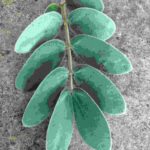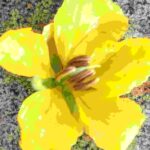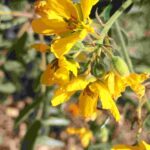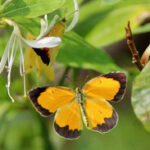Focus on a Native: Lindheimer’s Senna
by CMG Betty J

Senna Bush
Lindheimer’s senna, Senna lindheimeriana, is a perennial shrub of the pea family that has bright yellow flowers. It blooms from June-October with late summer being its prime season. It’s an upright bush that grows from three to six feet tall and is most often found in roadside ditches and at the edges of forested areas. The rocky limestone soil and sunny, hot weather of the Edwards Plateau is an ideal environment for this Texas native plant. It also grows in New Mexico, Arizona, and Mexico.
The leaves of this senna are divided into six to ten pairs of oval leaflets and densely covered with silky hairs. Since the leaves are covered in fuzzy hairs, the plant is also called velvet leaf senna and puppy-dog ears senna. The 1 ¼” wide flowers have five petals with ruffled edges. Of special interest are the stamens. Of the nine or ten stamens, only six to eight produce pollen. The others are sterile. The anthers curve upward and shed pollen grains from pores at the anthers’ tops or bottoms. Most other flowers have slits along the sides of the stamens where the pollen escapes. After the flowers have been pollinated, seed pods begin to form. The pods continue to grow until winter when they dry out, burst open, and the seeds inside disperse.

Senna Leaves

Senna Flower

Senna Flower Pods
As the name implies, the plant was named for Ferdinand Jakob Lindheimer, who is often called the Father of Texas Botany. This popular landscape shrub grows well in full sun or part shade, although the blooms are sometimes compromised by too much shade. Its height makes it a useful background specimen. It grows without manual watering; it can sometimes get leggy and will benefit from some prudent pruning. If senna is grown in a landscape setting, the seed pods should be harvested since it spreads with abandon. The root system is not particularly deep, however, so pulling up volunteers is not difficult.
Velvet leaf senna is a host plant for the Sleepy Orange butterfly and is frequently visited by bees. Its seeds are a good winter food source for birds and other wildlife. In cattle country, ranchers eradicate Lindheimer’s senna since it has proven poisonous to cows and horses when consumed in large amounts. The deer in the Hill Country usually leave it alone.

Sleepy Orange Butterfly
Lindheimer’s senna is a Texas native plant that will enhance any naturalized landscape setting. Plants are usually available at commercial nurseries.